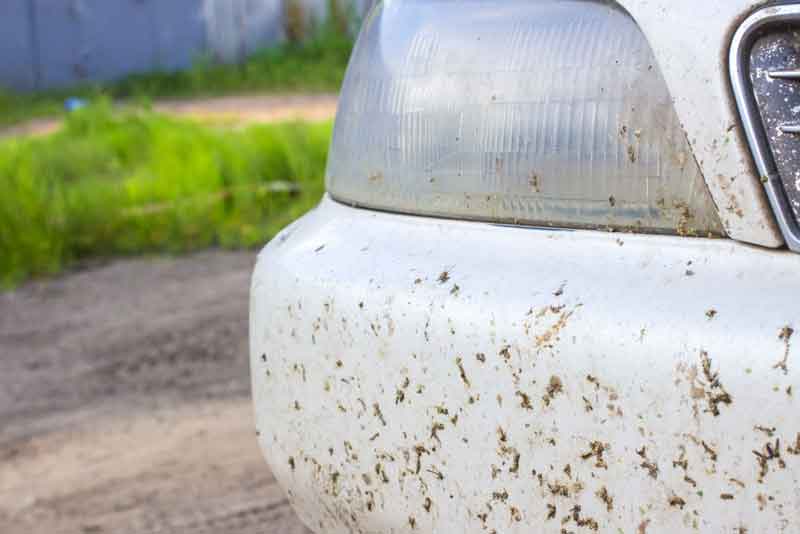Learn how to remove nasty tar without damaging your paintwork.
How does it find its way there? Often from road construction: Driving on freshly-created roads, newly re-carpeted surfaces, or even getting hit with some splotches from a careless road-worker. These lead to the all-too-frequent black blobs of tar ruining the appearance of your car.
Tar is inherently sticky—it has to be for its purpose. But it's also oil-based, making it harder to deal with than other sticky contaminants such as sap and bird droppings. One thing's for sure: ordinary car shampoo won't cut it.
Want to know how to remove these pesky patches? Read on for five ways on how.
Top Tip:
It is not recommended that you attempt to remove tar from your vehicle’s paintwork without a loosening agent as listed below. This is because the tar has bound to the clear coat and paintwork, and risks chipping or peeling off paintwork if removed with force. In such instances, a touch-up by a professional or even a panel respray may be in order.
Method 1 — Tar Remover
The most obvious option is to use a dedicated tar remover. These are solvent-based and will work to break down the oily, sticky substance without damaging your car’s paintwork.
Tar removers come in two forms: spray and paste. The spray removers are ideal for large areas low down on a car’s body—close to the wheel arches for example. This is because the nature of sprays means that the product is prone to drip.
For spots of tar that are placed higher on your vehicle’s body—such as on the tailgate—a paste is an excellent option. You can apply the paste and let it sit for a few seconds without worrying about it dripping onto non-tar-affected areas of your vehicle’s paintwork.
Top Tip:
Tar removal will strip your vehicle’s paintwork of any protection (in the form of waxes and sealants) that may have been present. It is essential that you reapply a good quality wax or sealant to the areas that have been treated. This will also ensure that future instances of tar on the vehicle’s paintwork are easier to remove.
Let the tar remover sit for up to 60 seconds, and then use a cloth or rag to remove the tar from the bodywork. This may require some effort, but it should be considerably looser. Be sure to remove all traces of the tar.
Tar remover is strong, but shouldn't damage the paintwork. Even so, you should ensure that you wash the panel with water and detergent thoroughly to remove any remains of the tar remover.
Method 2—Degreaser
What if you don’t have tar remover sitting around, or only have a few spots that you don’t feel would necessitate the purchase of an entire bottle? Not to worry, the chances are that you’ll have the next best thing when it comes to tar remover: a degreaser like WD-40.
WD-40 has a wide range of uses, and removing pesky spots of tar from your vehicle is one of them. WD-40 is also a solvent and will work to breakdown the substances within the tar.
Simply spray a liberal amount of WD-40 or other degreaser onto the spots of tar. You may want to let it sit for a couple of minutes, before agitating with a brush or cloth. Then, using a cloth, attempt to wipe away the tar.
For heavy areas of tarring, it may require several attempts at this. The WD-40 will act in stages, breaking down layers of the tar before you’re able to get to the base off the paintwork. But it remains a quick and simple way of removing tar.
Method 3—Mineral Spirits or Gasoline
Good for use when you don’t have anything else lying around, and stronger than degreaser, mineral spirits or gasoline is a surprisingly effective way to get rid of many gummy substances—including tar.
Soak a rag or cloth in spirit or gas, and begin tackling the areas that have tar on them. You can also use a spray bottle to target such areas effectively as well.
It is important to note that using such chemicals on your paintwork should be done with caution. Gasoline or spirit can eat into the paintwork if left to dry. Therefore, you must use detergent and clean water to rinse away any traces of gasoline or spirit left.
Safety Tip:
You may want to use a respirator when using this method. Bear in mind that the substances are highly flammable too.
Method 4 — Citrol Spray or Wipes
Thanks to their grease-cutting abilities, Citrus-based sprays and wipes are surprisingly good for tar removal. The wipes have the added benefit of not requiring the use of cloths or rinses either and can be handily stored in your car.
Spray Citrol on to the areas that are tar-effected, or simply use a wipe to dislodge the spots of tar, trapping them inside the disposable wipe. Do not be afraid to use too many wipes, as they dry out quickly and can harm the paint once used for more than one spot of tar.
Method 5—Clay Bar
A clay bar is a great way to remove several contaminants from your car. Although not our first choice for tar removal, it’ll still come through—with a bit of patience.
When using a clay bar, it is important to continually lubricate the surface you are working on. We recommend using running water, and detergent in a spray bottle.
It’s also important to fold the tar into the bar once it has been picked up; like kneading bread. This must be done to prevent the tar from scratching or sticking to the paintwork on subsequent passes.
After some elbow grease, you should be able to pick up all spots of tar with the clay bar.
